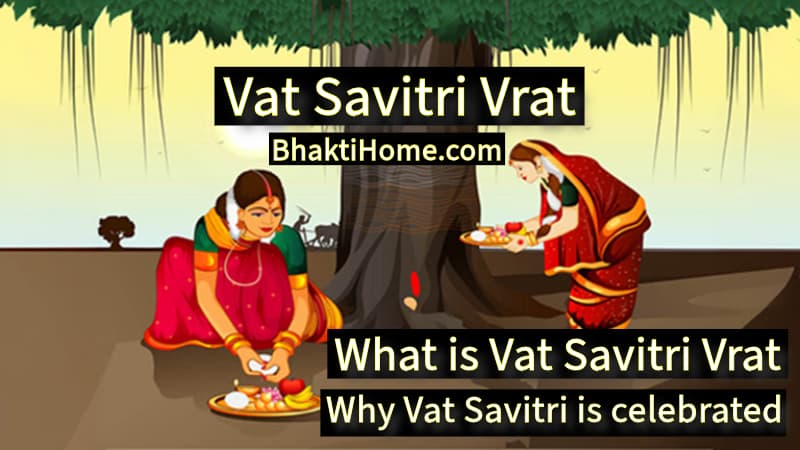
Vat Savitri Vrat is a sacred Hindu fast observed primarily by married women across various parts of India, especially in North India, Maharashtra, Gujarat, and Odisha.
Vat Savitri Vrat: Meaning, Significance, and Reasons Behind the Celebration
This vrat (fast) is dedicated to Goddess Savitri, who is revered for her unwavering devotion and determination that brought her husband, Satyavan, back to life. Celebrated on the Amavasya (no moon day) of Jyeshtha month, Vat Savitri Vrat holds deep cultural, spiritual, and even scientific relevance.
What is Vat Savitri Vrat?
The term “Vat Savitri” combines two words — “Vat” meaning the Banyan Tree, and “Savitri” referring to the devoted wife of Satyavan. Women who observe this vrat worship the banyan tree, tie sacred threads around its trunk, and pray for the long life, prosperity, and health of their husbands.
On this day, married women dress in traditional attire — often wearing red or yellow sarees, adorn themselves with mangalsutra, sindoor, bangles, and perform rituals with utmost devotion. They also listen to or recite the Savitri-Satyavan katha (story) which is the spiritual core of the occasion.
Spiritual Significance of Vat Savitri Vrat
The vrat commemorates the epic tale of Savitri, a devoted wife who faced Lord Yama, the god of death, to bring her husband Satyavan back to life. Her determination, intelligence, and purity of heart moved Yama, who granted her a boon to restore Satyavan's life.
This story, recorded in the Mahabharata, symbolizes the power of a devoted wife’s love and the victory of dharma (righteousness) over death and fate.
It teaches:
- The strength of commitment in marriage
- The spiritual power of prayer and fasting
- The belief that a woman’s faith and resolve can move even divine forces
Scientific Significance of Vat Savitri Vrat
Interestingly, beyond its spiritual context, Vat Savitri Vrat also carries scientific relevance:
1. Worship of the Banyan Tree (Vat Vriksha)
The banyan tree is known for its immense medicinal and environmental value. It releases a high amount of oxygen, even at night, and its leaves, bark, and roots have been used in Ayurveda for centuries to treat ailments like diabetes, diarrhea, and inflammation.
By encouraging women to gather around and tie threads to the tree, this ritual:
- Promotes environmental awareness
- Encourages the preservation of trees
- Enhances community bonding
2. Fasting and Detoxification
Fasting helps in cleansing the digestive system, improving mental focus, and boosting spiritual discipline. The timing of this vrat, during the peak summer season, is ideal for giving the body a natural detox.
Why is Vat Savitri Celebrated?
Vat Savitri is celebrated to honor the ideal of a devoted wife, and to invoke blessings for a long, healthy life of one’s spouse. It is a beautiful blend of love, sacrifice, and inner strength, passed down through generations.
At a deeper level, it is a celebration of:
- Feminine energy (Shakti) in its most resilient form
- The cyclical relationship between nature and human devotion
- The timeless values of marital fidelity, strength, and spiritual depth
📌 Most Asked FAQs about Vat Savitri Vrat
Q1. Who observes Vat Savitri Vrat?
Married Hindu women, particularly in North and Western India, observe this fast for the longevity and well-being of their husbands.
Q2. What is the importance of the banyan tree in Vat Savitri?
The banyan tree is symbolic of longevity, strength, and stability. Worshiping it is believed to bring similar qualities into one's marriage.
Q3. Is there a specific time to do the puja on Vat Savitri?
Yes, the puja is ideally done in the morning, especially during the Pratahkal or Sayamkal Muhurat, depending on regional customs.
Q4. Can unmarried women observe this vrat?
Traditionally, it’s meant for married women, but unmarried women may also observe it as a prayer for a good husband, similar to Karva Chauth or Hartalika Teej.
Q5. What is the story behind Vat Savitri Vrat?
It is based on the story of Savitri and Satyavan, where Savitri’s devotion brought her husband back from the clutches of death, impressing even Lord Yama.
Q6. Is there a difference between Vat Savitri Amavasya and Purnima?
Yes. In North India, it is observed on Amavasya (new moon), while in Maharashtra and Gujarat, it is often celebrated on Purnima (full moon) in Jyeshtha month.
Conclusion
Vat Savitri Vrat is more than a religious observance — it’s a living tradition that blends faith, love, nature worship, and scientific wisdom. In today’s modern age, this festival is a powerful reminder of the sacred bond of marriage, the importance of environmental respect, and the timeless value of inner strength and devotion.

